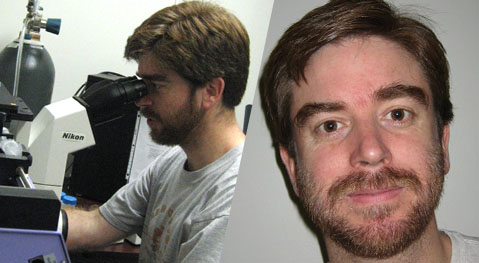Home > Press > HHMI Student Profile: Alfredo Celedon
 |
| Alfredo Celedon, HHMI NanoBioMed graduate student. Credit: INBT / JHU |
Abstract:
Nanoparticless open up enormous possibilities for scientists and engineers to study biomolecules, says Alfredo Celedon, a NanoBioMed graduate (pre-doctoral) trainee at the Johns Hopkins University Institute for NanoBioTechnology (INBT).
HHMI Student Profile: Alfredo Celedon
Baltimore, MD | Posted on November 13th, 2007"The ability to tailor magnetic nanoparticles, connect them to a biomolecule, and use the magnetic nanoparticle to manipulate the molecule is a very powerful concept. It will allow us to study the way different enzymes work, and it may even allow us to use them in new ways," Celedon says. "Proteins are perfect nanomachines, so it would be great to find ways to take advantage of their mechanisms."
The molecule of most interest to Celedon is chromatin, the complex of histone proteins and DNA that make up chromosomes in the nuclei of eukaryotic cells. Celedon is studying the mechanical properties of chromatin by observing chromatin condensation under different biologically relevant conditions.
"If you modify the histones, you change the way the chromatin behaves," Celedon says. "When the chromatin condenses, the structure is tightly held, and there is no access to the DNA. If the chromatin is less condensed, the histones are more loosely held, and access to the DNA is permitted. Cells control gene expression in this way.''
Using nanoparticles and magnetic tweezers, Celedon has been able to exert forces on the chromatin fiber to study its response. He hopes these experiments will shed light on the generally held hypothesis that there is a "histone code" that guides interactions between enzymes and DNA.
Modified histones are prepared in the lab of INBT affiliate Greg Bowman, assistant professor of biophysics at the Krieger School of Arts and Sciences. Magnetic nanoparticles are fabricated in the lab of Peter Searson, professor of materials science and engineering and director of INBT. Experiments using the magnetic tweezers experiments are conducted under an inverted optical microscope in the INBT's laboratory located in the Whiting School of Engineering. Celedon's advisors include INBT affiliate Sean Sun, assistant professor of mechanical engineering, and Denis Wirtz, professor of chemical and biomolecular engineering and INBT's associate director.
"I had previously attempted to model these concepts theoretically," Celedon says. "Through the guidance of my advisors and INBT, we have developed a way to test these
####
About Institute for NanoBioTechnology
The Institute for NanoBioTechnology at Johns Hopkins University will revolutionize health care by bringing together internationally renowned expertise in medicine, engineering, the sciences, and public health to create new knowledge and groundbreaking technologies.
INBT programs in research, education, outreach, and technology transfer are designed to foster the next wave of nanobiotechnology innovation.
Approximately 150 faculty are affiliated with INBT and are also members of the following Johns Hopkins institutions: Krieger School of Arts and Sciences, Whiting School of Engineering, School of Medicine, Bloomberg School of Public Health, and Applied Physics Laboratory.
For more information, please click here
Contacts:
* Institute for NanoBioTechnology
214 Maryland Hall
3400 North Charles Street
Baltimore, MD 21218
* Email:
* Phone: (410) 516-3423
* Fax: (410) 516-2355
Copyright © Institute for NanoBioTechnology
If you have a comment, please Contact us.Issuers of news releases, not 7th Wave, Inc. or Nanotechnology Now, are solely responsible for the accuracy of the content.
| Related News Press |
Academic/Education
![]() Rice University launches Rice Synthetic Biology Institute to improve lives January 12th, 2024
Rice University launches Rice Synthetic Biology Institute to improve lives January 12th, 2024
![]() Multi-institution, $4.6 million NSF grant to fund nanotechnology training September 9th, 2022
Multi-institution, $4.6 million NSF grant to fund nanotechnology training September 9th, 2022
Announcements
![]() NRL charters Navyís quantum inertial navigation path to reduce drift April 5th, 2024
NRL charters Navyís quantum inertial navigation path to reduce drift April 5th, 2024
![]() Discovery points path to flash-like memory for storing qubits: Rice find could hasten development of nonvolatile quantum memory April 5th, 2024
Discovery points path to flash-like memory for storing qubits: Rice find could hasten development of nonvolatile quantum memory April 5th, 2024
|
|
||
|
|
||
| The latest news from around the world, FREE | ||
|
|
||
|
|
||
| Premium Products | ||
|
|
||
|
Only the news you want to read!
Learn More |
||
|
|
||
|
Full-service, expert consulting
Learn More |
||
|
|
||








